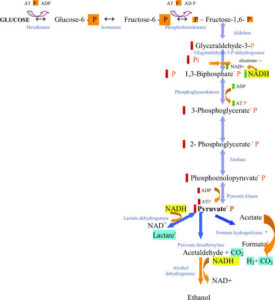Back to: MICROBIOLOGY 200 LEVEL
Welcome to class!
Hello brilliant learner! It’s always a joy to have you here. You’re doing great, and today’s topic is a special one—Glycolysis (Embden-Meyerhof Pathway). It may sound big, but trust me, by the end of this lesson, you’ll understand it so well, you’ll be able to explain it to someone else using relatable, everyday examples. Let’s get started!
Glycolysis (Embden-meyerhof Pathway)
What is Glycolysis?
Glycolysis is the process by which glucose (a simple sugar) is broken down in cells to produce energy in the form of ATP. It is the first step in cellular respiration, and it takes place in the cytoplasm of all living cells—whether in humans, plants, or tiny microbes like bacteria.

The Embden-Meyerhof pathway is the most common type of glycolysis, named after the scientists who discovered it. It’s how most microbes, including many bacteria, extract energy from glucose.
Why is Glycolysis Important?
Imagine you just ate a plate of rice and stew. The glucose from that food enters your cells. Through glycolysis, your cells unlock the energy stored in the glucose. This energy is then used for all sorts of activities—moving, growing, repairing cells, and more.
Stages of Glycolysis (Embden-Meyerhof Pathway)
Glycolysis happens in two main phases:
1. Energy Investment Phase (uses 2 ATP)
In this phase, the cell uses 2 ATP molecules to prepare glucose for breakdown:
One glucose molecule (6 carbon atoms) is phosphorylated using ATP.
It gets converted into fructose-1,6-bisphosphate, which then splits into two 3-carbon molecules called G3P (glyceraldehyde-3-phosphate).
2. Energy Payoff Phase (produces 4 ATP and 2 NADH)
Now the cell starts gaining energy:
Each G3P is converted through several steps into pyruvate (a 3-carbon compound).
In the process, the cell produces:
4 ATP molecules
2 NADH molecules (electron carriers)
Since it used 2 ATP earlier, the net gain is 2 ATP.
So, from one glucose molecule, glycolysis produces:
2 pyruvate
2 ATP (net)
2 NADH
Think of glycolysis like charging your phone with a power bank:
First, you connect the wire (energy investment—you use some battery).
Then the phone charges (energy payoff—you gain more battery than you used).
The glucose is the power bank, and ATP is the charged phone—it powers all your activities.
In microbes, glycolysis gives them quick energy, especially when oxygen is not available. This is why some microbes rely on it fully to survive.
What Happens to Pyruvate?
The pyruvate made in glycolysis can go down different paths:

If oxygen is present (aerobic), it enters the Krebs cycle and Electron Transport Chain to produce more ATP.
If oxygen is not present (anaerobic), it may be converted into lactic acid or ethanol—common in some microbes and also in our muscles during heavy exercise.
Summary
- Glycolysis is the breakdown of glucose into pyruvate, producing energy.
- It happens in the cytoplasm and doesn’t need oxygen.
- The process uses 2 ATP and makes 4 ATP and 2 NADH—net gain of 2 ATP.
- Glycolysis is vital for both microbes and humans to generate quick energy.
Evaluation
- Where does glycolysis take place in the cell?
- What is the net gain of ATP from one glucose molecule in glycolysis?
- Name the two phases of glycolysis.
- What happens to pyruvate after glycolysis?
Amazing work today, my superstar! You’ve just unlocked the secret of how cells tap into food energy—and that’s a huge deal in biology. Every step you take with Afrilearn brings you closer to mastery and greatness. Keep shining, and I can’t wait to learn more with you in the next class. You’re doing excellently well!
